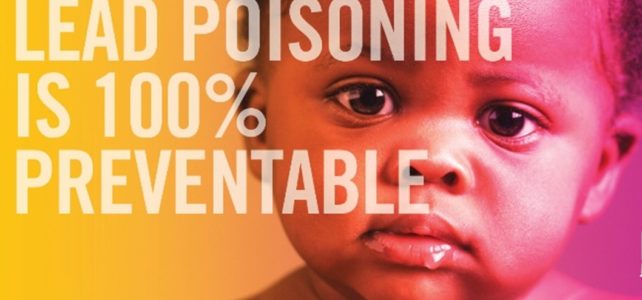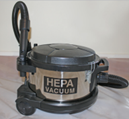

Research shows NO amount of lead exposure is safe for children. Childhood lead poisoning is the most common environmental disease of young children. Even low levels of lead in blood have been shown to affect learning and academic achievement. Lead can damage nearly every system in the human body and has harmful effects on both adults and children. The most concerning aspect of lead poisoning is that children may display no signs or symptoms of being lead poisoned. Only way to know if your child has an elevated blood lead level is a blood test. Visit our Lead Testing page for more information.
Lead exposure occurs when a child comes in contact with lead by: touching, swallowing, or breathing in lead or lead dust. Childhood exposure to lead can cause long-term harm and the effects of lead exposure may be permanent. If caught early further exposure can be prevented.
The Clark County Combined Health District (CCCHD) supports primary and secondary lead exposure prevention.
Primary prevention: is the removal of lead hazards from the environment before a child is lead exposed. It is the most effective way to ensure that children do not experience harmful long-term effects of lead exposure.
Secondary prevention: includes blood lead testing and follow-up care and referral. Testing children’s blood for lead is an essential safety net for those who may already be exposed to lead.
Ohio law requires primary health care providers to administer blood lead tests to:
- ALL Medicaid children at age one and two
- Children less than six years of age living in identified high risk zip codes
- Children ages three to six not previously tested.
The Ohio Department of Health determines high-risk zip code areas. Clark County high-risk zip codes include: 45502, 45503, 45504, 45505, 45506, 45324, 43078, 43140, and 45387.
Where is Lead Found?
Lead sources are often found in homes built prior to 1978 due to the widespread usage of lead based paint during that time.
Children who live in or spend 6 hours or more a week in homes built prior to 1978 are at high risk of lead poisoning, along with children who have siblings that have had lead poisoning.
Dust containing lead particles is the primary source of childhood lead poisoning, but lead can be found throughout a child’s environment:
- Homes built before 1978 probably contain lead based paint. When the paint peels and cracks, it makes lead dust. Children can be exposed to lead when they swallow or breathe in lead dust.
- Certain water pipes may contain lead. To reduce any possible exposure, run cold water through the tap for 30-60 seconds before use, as stagnant water is more likely to carry lead particles. Lead cannot be boiled out of water.
- Lead can be found in some products such as toys and jewelry.
- Lead is sometimes in candies or traditional home remedies.
- Certain jobs and hobbies involve working with lead based products.
- Jobs working at a gun range, serving as a police officer or soldier and some manufacturing jobs, like battery production, may cause parents to bring lead into the home.
- Children who live near airports may be exposed to lead in air and soil from aviation gas.
Protecting my Family from Lead
Simple Steps to Protect Your Family from Lead Hazards
- Talk to your child’s healthcare provider about scheduling a lead blood test or call CCCHD to schedule a blood lead test. CCCHD testing is done by appointment only.
- Wash children’s hands often and well before eating and at bedtime, and frequently wash their bottles, pacifiers, and toys.
- Keep an intact coat of latex paint over top of older paint so that children can’t have access to the older paint – lead based paint is only dangerous if it is exposed.
- Regularly check all painted surfaces of your home for chipping or peeling – looking carefully at painted areas that rub together, like doors, windows, and stairways.
- Renting? Talk to your landlord about fixing surfaces with peeling or chipping paint.
- Prevent your child playing in bare soil. Soil, yards, and playgrounds can contain lead. Wash your child’s hands after coming in from outside, and before eating.
- A well-rounded diet rich in iron, calcium and
 vitamin C reduces lead absorption keeping it from entering blood and bones.
vitamin C reduces lead absorption keeping it from entering blood and bones. - Use lead safe cleaning methods at home – wear gloves, place paint chips in a plastic bag that closes tightly, use a spray bottle of water and damp paper towels to help reduce dust when dusting, use the spray bottle of water to dampen small paint chips before sweeping them up (dry dusting and sweeping spreads lead dust particles over a larger area), put used paper towels in the same trash bag used for paint chips, seal the bag and put it out with the regular trash. Wash hands after cleaning.

- Always use a vacuum with a High Efficiency Particulate Air (HEPA) filter. A HEPA filter can remove very fine particles from air at 99.97% efficiency. Regular household vacuums release small particles of lead into the air, which spreads lead dust around rather than removing it.
- Don’t have a HEPA vacuum? CCCHD has a free HEPA vacuum rental program for Clark County residents.
- Other dust control methods for friction surfaces include carpeting stairways, replacing windows, or installing window wells or window track liners.
- If you work with lead, leave your shoes outside, immediately shower, and wash your work clothing separately from the regular laundry.
- If you DIY home projects, keep your family safe by knowing and following lead safe practices.
- OR Hire an Ohio Department of Health (ODH) lead safe service provider to do home renovating, repairs, and painting. Click here to access ODH’s searchable database of licensed lead safe service providers.
HEPA Vacuum Rental Program
Clark County Healthy Homes and Childhood Lead Poisoning Prevention work together to make (High Efficiency Particulate Air) (HEPA) filter vacuums available for county residents at no cost. Industrial HEPA vacuums are specifically designed to capture hazardous materials such as lead dust particles at 99.97% efficiency.
The loaner program is a free service to Clark County residents, and a HEPA vacuum can be borrowed for up to three days. You must call ahead to reserve a vacuum. You must also provide a valid driver’s license or state ID and a home address (no P.O. boxes). Loaner vacuums are to be used for dry household cleaning ONLY and must be returned emptied and clean. An Ohio Department of Health video demonstrating use of a HEPA vacuum and how to clean it after use is available here.
To reserve a HEPA vacuum, contact the Caroline Quelette at CCCHD between 8 a.m. and 4:30 p.m. on Monday through Friday: 937-390-5600 or by email at cquelette@ccchd.com
Financial Resources for Lead Abatement
If you need financial assistance for the removal of lead in your home, please use the following links to explore possible options.
Is there lead in Clark County Water?
Thankfully, Springfield has very low to zero lead exposure in its water systems. Click on the following jurisdiction names for information on lead levels in their water supplies: North Hampton, New Carlisle, Park Layne, South Charleston, and Enon. For jurisdictions not listed, please contact your local water treatment facility and/or local government.

